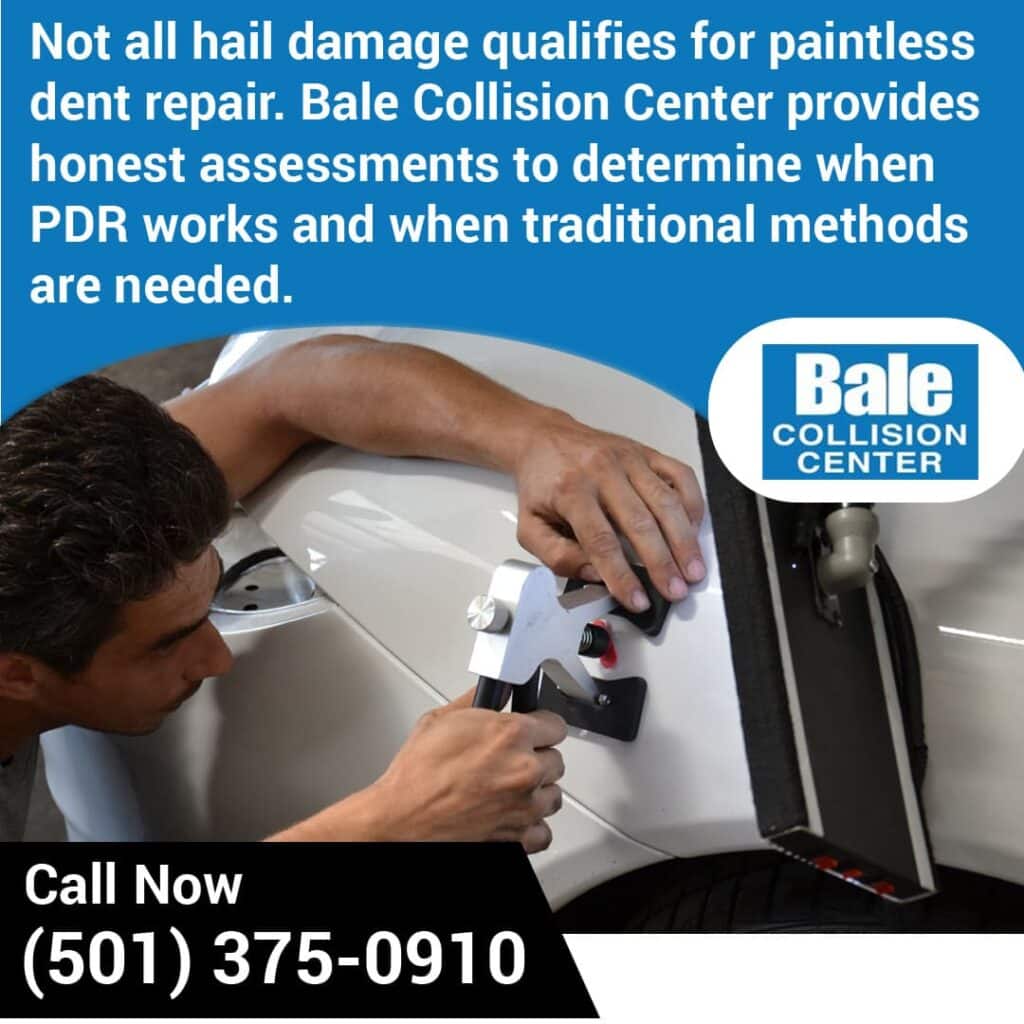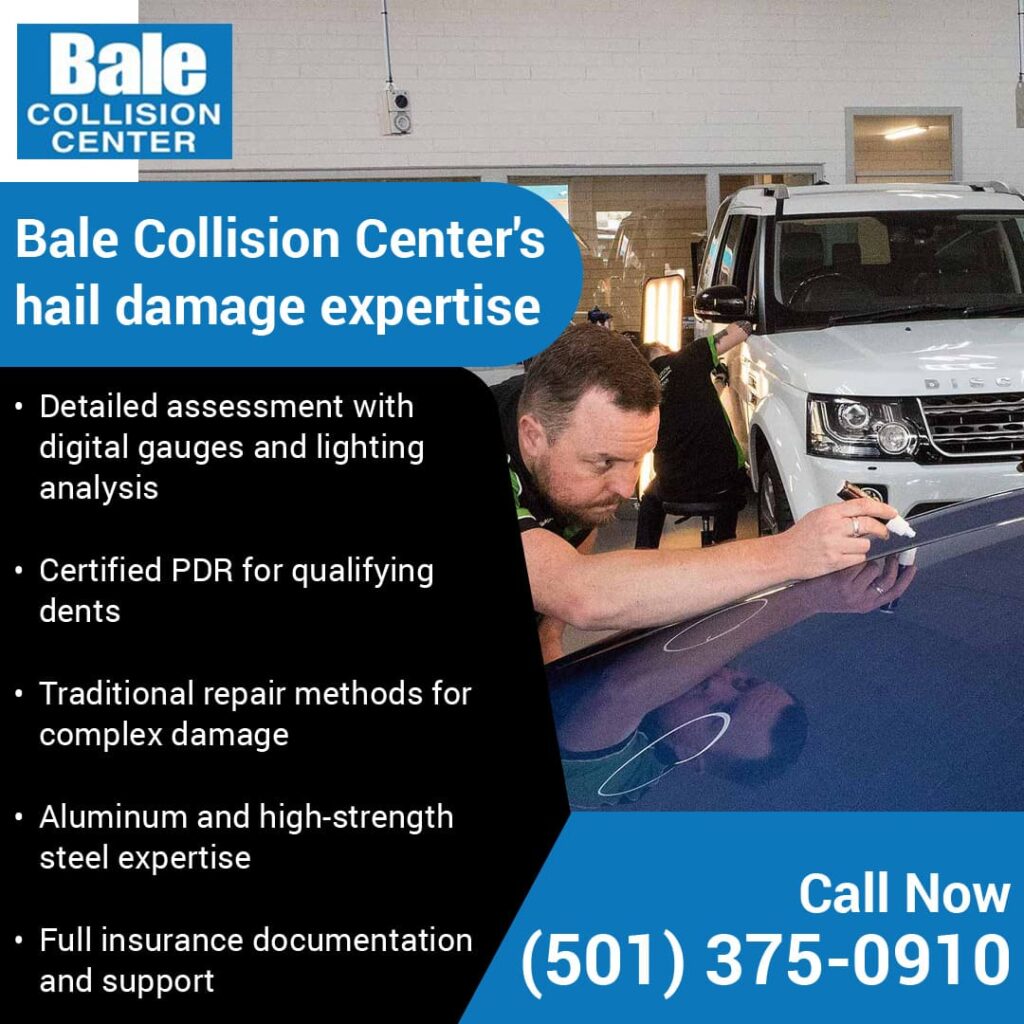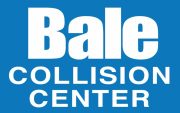Arkansas storms can leave vehicles with varying degrees of hail damage. Damage ranges from shallow surface dents to deep metal deformation that requires extensive repair work. Understanding the difference between damage suitable for paintless dent repair (PDR) and damage requiring traditional auto body repair methods helps vehicle owners make informed decisions about their repair options.
PDR works effectively under specific conditions. The paint must remain intact, dents should measure under 2-3 inches in diameter, metal must retain elasticity without stretching, and technicians need access to damage from behind panels. However, when hailstones crack paint, create sharp creases, stretch metal beyond its elastic limit, or impact reinforced structural areas, traditional methods become necessary.
At Bale Collision Center (Downtown), we provide expert hail damage repair in Downtown Little Rock, AR, using advanced diagnostic tools and certified technicians. We assess damage systematically to identify when car dent removal through paintless techniques remains viable versus when traditional auto body repair methods better serve your restoration needs.

PDR Fundamentals for Hail Impact Assessment
Paintless dent repair removes dents without disturbing factory paint. The technique manipulates damaged metal back to its original position from behind the panel. Technicians access the damage through existing openings or by carefully removing interior trim, then use specialized tools to gradually massage the metal outward. This process relies on the metal’s natural memory to return to its original shape.
The technique preserves the vehicle’s factory finish, eliminating color-matching concerns that arise with repainting. Modern automotive paints have improved elasticity compared to older formulations, expanding PDR viability for larger dents than previously possible.
Success depends on specific damage characteristics rather than size alone. Paint flexibility, metal type, dent depth, and access points determine whether PDR will achieve factory-quality results.
In many cases, hail damage qualifies for PDR treatment, while some repairs require conventional body methods involving fillers, sanding, and repainting.
Paint Integrity as the Primary Determining Factor
Paint condition determines PDR viability more than any other single factor. Intact paint with underlying dents qualifies for paintless repair, while any paint disruption requires traditional methods.
Paint Damage Types and Repair Requirements
| Damage Type | Common Causes | Why PDR Won’t Work | Required Action |
| Cracked Paint | Hailstones at certain angles or in cold temps | Paint layer disrupted despite shallow dents | Traditional methods with repainting |
| Chipped Paint | Sharp or irregular hailstones | Bare metal exposed; oxidation risk | PDR first, then paint repair to seal exposed areas |
Cracked Paint Indicators
Hailstones striking at certain angles or velocities can crack the paint layer despite creating relatively shallow dents. This occurs most frequently on roof rails, hood surfaces, and trunk lids, where the impact angle concentrates force.
Temperature at the time of impact affects paint flexibility. Cold weather reduces paint elasticity and increases the likelihood of cracking even from moderate-sized hail. A vehicle exposed to quarter-sized hail in freezing conditions may sustain more paint damage than one hit by larger hail during warmer temperatures.
Chipped Paint Damage
Sharp or irregularly shaped hailstones can chip paint away entirely, exposing bare metal beneath. These areas require immediate attention because exposed metal oxidizes rapidly, especially in Arkansas’s humid climate.
Even small paint chips measuring only a few millimeters create entry points for moisture. If it is left unaddressed, rust can spread beneath surrounding paint, requiring more extensive repair work than the original damage.
When paint chips accompany dents, technicians must address both issues. The dented metal receives paintless dent repair treatment first, followed by paint repair to seal the exposed areas and prevent corrosion.
Dent Characteristics That Exceed Repair Thresholds
Size and Depth Limitations
Dent size and depth work together to determine PDR viability:
- Small dents (smaller than a quarter) typically respond well to PDR techniques
- Medium dents (quarter to half-dollar size) remain viable candidates if other factors align favorably
- Large dents (exceeding 2-3 inches in diameter) often require traditional repair methods
Depth matters more than diameter in many cases. Shallow depressions measuring 3 inches across may receive successful treatment. A 1-inch dent with significant depth could exceed repair thresholds. The ratio between width and depth determines whether the metal has stretched beyond its elastic recovery point.
Metal Stretching Beyond Elastic Limits
Metal possesses elastic properties that allow it to return to its original shape after deformation within certain limits. When force exceeds these limits, the metal stretches permanently, creating a larger surface area than existed before impact.
Visual indicators of metal stretching include:
- Sharp edges around the dent perimeter
- Visible ridges
- Areas where the surface appears thinner than the surrounding metal
These characteristics signal that simple manipulation cannot restore the original contour. Stretched metal requires traditional body repair techniques. Technicians must shrink the metal through controlled heat application or use body filler to recreate the proper surface contour before refinishing.
Location-Based Access Challenges
Panel Edge and Body Line Obstacles
Dents occurring along panel edges, body seams, or character lines present access challenges that often prevent effective repair. The tools used for paintless dent removal services need clear access paths to the damage from behind, which reinforcement structures near edges typically block.
Vehicle areas that create access challenges include:
- Hood edges: Reinforced for latch mechanisms, creating double-wall construction
- Roof rails: Contain internal reinforcement that blocks PDR access points
- Door edges: Feature complex internal structures near window frames
Body lines that define a vehicle’s styling add complexity to repairs. Dents that distort these intentional creases require precise metal manipulation that exceeds repair capabilities when the damage severity reaches certain thresholds.
Structural Panel Limitations
Modern vehicles incorporate specific panels as part of the safety structure. Roof panels, A-pillars, and certain body sections contain reinforcement that serves crash protection functions. These areas feature multiple layers or internal bracing that prevent tool access.
Advanced Driver Assistance Systems (ADAS) often mount sensors to roof panels or behind bumpers. Damage to these mounting surfaces may affect sensor calibration even if the visible dent seems minor. Traditional car dent removal methods that allow proper sensor remounting become necessary in these scenarios.
Severe Hail Damage Scenarios
Multiple Large Impact Zones
Hailstorms producing stones larger than golf balls can create damage concentrations that make individual dent repair impractical. When a single panel contains 50 or more substantial dents, the cumulative repair time and cost may exceed panel replacement expenses.
Arkansas experienced hailstorms in recent years, with stones reaching baseball size in some areas. These events created damage patterns where vehicles sustained hundreds of dents across multiple panels, with some requiring complete panel replacement due to the density and severity of impacts.
Sharp Creases and Complex Deformation Patterns
Hailstones striking at oblique angles can create crease-type damage rather than round depressions. These sharp-edged deformations involve metal folding that standard techniques cannot address effectively.
When multiple hailstones strike the same area in rapid succession, they can create overlapping damage patterns with complex deformation. The metal in these zones experiences stress from multiple directions, creating irregular surface topology that defies systematic repair approaches.
Combination Repair Approaches
When hail damage includes both PDR-suitable dents and areas requiring traditional repair, certified collision centers use combination approaches. Technicians apply paintless methods to qualifying damage while addressing paint cracks and severe deformation through conventional techniques.
This approach minimizes refinishing work to only those panels where paint damage occurred. Preserving factory paint on panels suitable for treatment maintains the vehicle’s original finish quality while controlling repair costs.
At Bale Collision Center, our certified PDR technicians work alongside our body repair specialists. This integration allows seamless combination repairs that optimize the approach for each damaged panel. Our technicians categorize each dent by size, depth, location, and paint condition. This systematic approach creates a repair plan that applies the most appropriate technique to each affected area.
Vehicle-Specific Material Considerations
Material-Specific Repair Considerations
| Material | Common Vehicles | Key Characteristics | PDR Limitations |
| Aluminum | Luxury vehicles, newer trucks | Lower elasticity than steel | Smaller size threshold for viable repair |
| High-Strength Steel | Vehicles manufactured after 2015 | Increased tensile strength; resistant to manipulation | Requires more aggressive tool pressure; higher paint damage risk |
Technicians must identify panel materials and select appropriate car dent removal techniques and set realistic expectations for outcomes.
Total Loss Determination Factors
Repair Cost Versus Vehicle Value
Insurance companies total vehicles when repair costs approach or exceed the vehicle’s actual cash value. In Arkansas, this often occurs when repair estimates reach a high percentage of the pre-damage value.
Comprehensive hail damage, creating hundreds of dents, can generate repair costs exceeding $10,000. For vehicles valued below $15,000, this damage level often results in total loss designation despite the structural integrity remaining sound.
The salvage value calculation factors into this determination. Insurers compare repair costs against what they could recover by selling the damaged vehicle at auction. When the math favors selling the vehicle as-is, they declare it a total loss.
Structural Safety Concerns
Hail damage severe enough to compromise structural integrity automatically triggers total loss consideration regardless of vehicle value. This situation remains rare with hail alone, but it can occur when falling tree limbs accompany the storm.
Roof panel damage affecting the vehicle’s rollover protection structure requires replacement rather than repair under OEM procedures. The costs associated with proper structural repair following manufacturer guidelines often exceed economic repair thresholds.
Expert Hail Damage Assessment in Little Rock, AR
Damage Evaluation Process
Our technicians examine every dent to measure its size, depth, and location. We check paint conditions to identify cracks or chips that disqualify PDR. Each assessment determines whether the metal has stretched beyond repair limits or can return to its original shape.
We use specialized gauges to measure dent depth and paint thickness. This equipment reveals damage severity that visual inspection alone might miss. Our evaluation identifies which dents qualify for paintless repair and which require traditional dent removal services.
Testing Panel Access for PDR
Before recommending PDR, we verify that technicians can reach the damage from behind the panel. We check for internal bracing and structural reinforcements that block tool access. This step prevents recommending repairs that cannot be completed successfully.
For aluminum panels and high-strength steel, we perform additional testing. These materials require different techniques than standard steel, and our assessment determines the appropriate repair method for each panel type.
Repair Planning and Cost Options
When hail damage includes both PDR-suitable dents and severe damage, we create a combined repair plan. This approach uses paintless repair where possible and traditional methods where necessary, controlling costs while achieving complete restoration.
We explain the differences between PDR, combination repairs, and panel replacement. Our team provides clear cost comparisons so vehicle owners understand their options and why certain damage requires specific repair methods.
Insurance Claim Support
We document hail damage with photographs and measurements for insurance claims. Our detailed assessments show adjusters that damage qualifies for PDR and which require traditional repair, providing clear justification for recommended work.
Bale Collision Center works with all major insurance companies. We handle claim documentation and communicate directly with adjusters throughout the repair process, simplifying the experience for vehicle owners.

Work with Certified Professionals for Damage Evaluation
Determining whether hail damage falls within repair limits requires professional assessment by certified technicians using proper diagnostic equipment. The interaction between paint condition, metal characteristics, dent location, and access limitations creates a complex evaluation that experience and training inform.
Bale Collision Center combines over 70 years of Arkansas service with modern diagnostic technology and certified expertise. Our I-CAR Gold facility provides accurate assessments that identify the most effective repair approach for your specific damage.
Get a Hail Damage Evaluation Today
Call Bale Collision Center at (501) 375-0910 or email bccdowntown@baleautomotive.com for expert hail damage repair in Downtown Little Rock, AR. Our certified specialists will assess your vehicle’s damage and recommend the appropriate dent removal services for your situation. We work directly with all major insurance providers to streamline your claim process and restore your vehicle to pre-storm condition.
Serving Downtown Little Rock and nearby areas.
